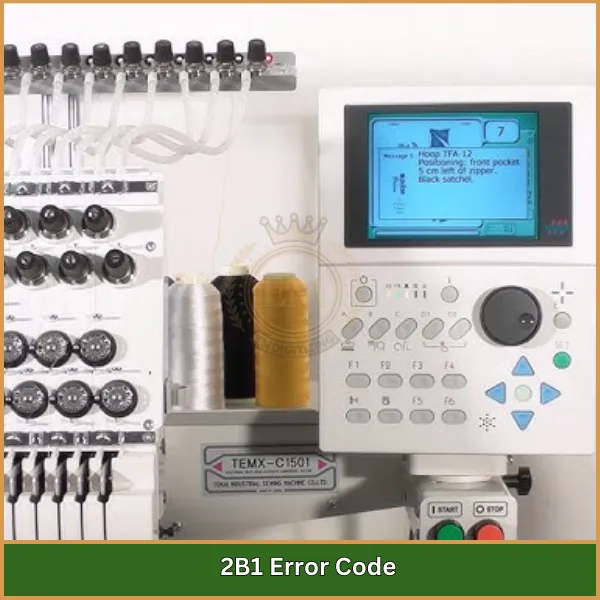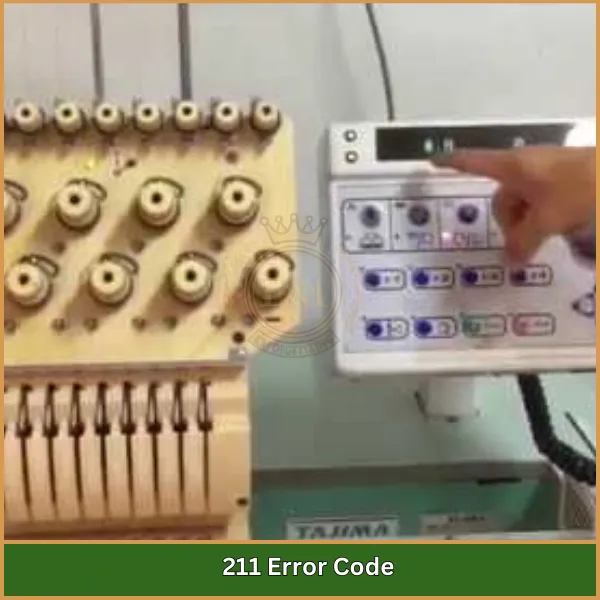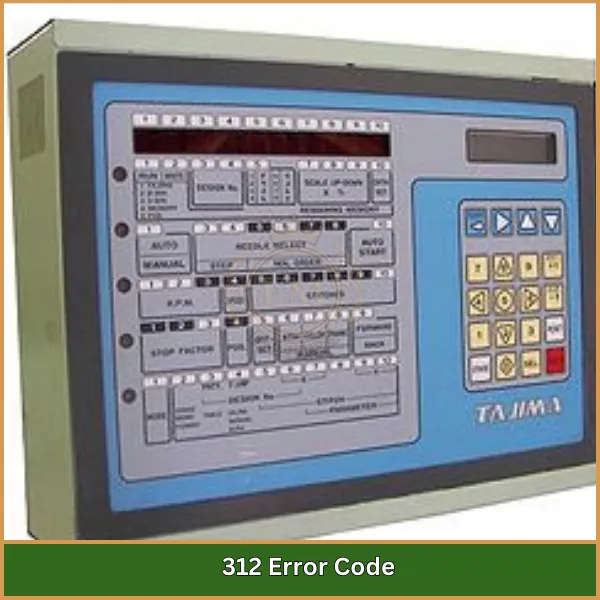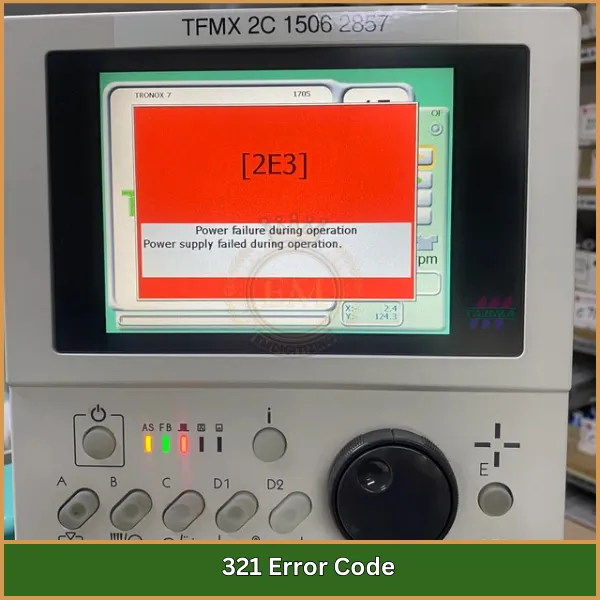Si vous avez déjà vu des codes d’erreur Tajima apparaître sur votre machine à broder, tu sais à quel point ça peut être frustrant. These codes are the machine’;C'est une façon de te dire que quelque chose a besoin d'attention, des petits ajustements aux ajustements plus spécifiques.
En apprenant la signification de chaque code d'erreur, vous pouvez gagner du temps et résoudre rapidement les problèmes au lieu de vous fier aux conjectures. Dans cet article, nous passerons en revue certains des codes Tajima les plus courants, expliquer ce qui pourrait les causer, et vous proposons des solutions simples pour que votre broderie continue de fonctionner correctement..
Let’;Nous décomposons ces codes pour les rendre plus faciles à gérer!

Codes d’erreur Tajima de la machine à broder avec solutions
15 Codes d’erreur Tajima courants
Voici quelques erreurs typiques que vous pourriez voir sur Machines à broder Tajima. Chaque code pointe vers un problème spécifique, vous aidant à identifier et à résoudre rapidement les problèmes.
- 2Code d'erreur B1
- 2Code d'erreur B2
- 2Code d'erreur B3
- 2Code d'erreur B4
- 2Code d'erreur B5
- 3Code d'erreur D6
- Code d'erreur BC1
- 211 Code d'erreur
- 311 Code d'erreur
- 312 Code d'erreur
- 313 Code d'erreur
- 314 Code d'erreur
- 316 Code d'erreur
- 321 Code d'erreur
- 322 Code d'erreur
Pour chaque code d'erreur, nous examinons pourquoi cela se produit et comment le résoudre efficacement. Cette approche permet d'identifier le problème exact et d'appliquer rapidement le bon correctif..
2Code d'erreur B1

Cette erreur fait allusion à un problème de connexion, impliquant spécifiquement un périphérique série comme un ordinateur que la machine ne peut pas détecter ou avec lequel communiquer. Ceci est classé sous les codes d’erreur Tajima liés à la connectivité.
Solutions
- Vérifiez les connexions série: Confirmez que tous les périphériques série sont correctement branchés et allumés.
- Redémarrer les appareils: Éteignez la machine à broder et tous les appareils connectés, puis rallumez-les pour rafraîchir la connexion.
- Valider les données de conception: Assurez-vous que les données de conception envoyées sont correctes; vérifier les formats de fichiers compatibles.
- Inspecter les câbles: Recherchez les câbles endommagés qui pourraient rompre la connexion.
2Code d'erreur B2
Ce code apparaît en cas de problème avec les données de point, généralement dû à des codes d'erreur Tajima complémentaires incompatibles ou manquants.
Solutions
- Corriger la saisie des données: Passez en revue vos données de conception et corrigez les erreurs de saisie.
- Réintégrer le design: Si besoin, ré-entrez vos données de conception à l'aide de votre logiciel de broderie pour éviter les problèmes.
- Utiliser un logiciel mis à jour: Assurez-vous que votre logiciel est compatible avec les machines Tajima pour éviter les problèmes de compatibilité.
2Code d'erreur B3
Cette erreur signale que des éléments supplémentaires, des données involontaires ont été laissées à la fin d'une séquence de code, ce qui peut dérouter la machine.
Solutions
- Formatage de la révision: Vérifiez vos données de conception pour toute donnée supplémentaire ou égarée à la fin de la séquence et supprimez-la.
- Réenregistrer les fichiers: Enregistrez à nouveau vos fichiers de conception dans un format compatible avec la machine.
- 1 DFAE: Considérez cet identifiant pour un dépannage plus approfondi en cas de problèmes complexes.
2Code d'erreur B4
Ce code signifie que les codes de points lus par la machine ne suivent pas le format requis, ce qui conduit à des erreurs.
Solutions
- Vérifier le format du code: Assurez-vous que tous les codes de points correspondent au format standard de Tajima.
- Utilisez un logiciel approprié: Créez uniquement des conceptions à l'aide d'un logiciel conçu pour les machines Tajima afin d'éviter les erreurs de formatage..
2Code d'erreur B5
Cette erreur apparaît lorsqu'une longueur de point dans votre motif dépasse la longueur de la machine. 5.1 limite en mm. 1 DFA peut également s'appliquer ici.
Solutions
- Réduire la longueur des points: Accédez à votre motif et ajustez tous les points qui dépassent la limite..
- Simplifiez les conceptions complexes: Pour des designs complexes, envisager de simplifier les sections ou de les diviser en parties plus petites pour éviter de surcharger la machine.
3Code d'erreur D6
Le code d'erreur Tajima 3D6 indique un problème avec le programme de la machine ou la carte CPU, souvent en raison de problèmes logiciels ou d'une installation incorrecte.
Solutions
- Réinstaller le logiciel: Utilisez le disque d'installation ou téléchargez le dernier logiciel depuis le site Tajima pour le réinstaller sur la carte CPU.
- Carte CPU sécurisée: Assurez-vous que la carte CPU est correctement connectée et insérée dans son emplacement..
- Contacter l'assistance: Si le problème persiste, contactez l'assistance de Tajima pour obtenir des conseils.
- Réinitialisation du système: Pour certains modèles, une réinitialisation du système peut aider; consultez le manuel d'utilisation pour les instructions de réinitialisation.
Code d'erreur BC1
Le code d'erreur BC1 Tajima apparaît lorsque la machine ne parvient pas à localiser un dessin sur la disquette ou n'y trouve aucun dessin enregistré..
Solutions
- Vérifier le contenu du disque: Assurez-vous que la disquette contient des fichiers de conception valides, et essayez un autre disque si nécessaire.
- Vérifier la compatibilité: Confirmez que la disquette est compatible avec le modèle de votre machine spécifique.
- Essayez un autre design: Si un modèle n'est pas trouvé, essayez d'en sélectionner un autre sur le disque.
- Examiner le lecteur de disque: Examinez les problèmes mécaniques potentiels avec le lecteur de disquette.
Code d'erreur BC1
Le code d'erreur BC1 Tajima apparaît lorsque la machine ne parvient pas à localiser un dessin sur la disquette ou n'y trouve aucun dessin enregistré..
Solutions
- Vérifier le contenu du disque: Assurez-vous que la disquette contient des fichiers de conception valides, et essayez un autre disque si nécessaire.
- Vérifier la compatibilité: Confirmez que la disquette est compatible avec le modèle de votre machine spécifique.
- Essayez un autre design: Si un modèle n'est pas trouvé, essayez d'en sélectionner un autre sur le disque.
Examiner le lecteur de disque: Examinez les problèmes mécaniques potentiels avec le lecteur de disquette.
211 Code d'erreur

Le Tajima 211 le code d’erreur signifie que l’arbre principal de la machine n’est pas dans la bonne position, ce qui est crucial pour un fonctionnement précis.
Solutions
- Ajuster l'arbre principal: Positionnez manuellement l'arbre principal à son emplacement approprié selon votre manuel.
- Vérifier les signaux de l'encodeur: Nettoyez et inspectez l'encodeur pour vous assurer qu'il fonctionne comme prévu.
- Redémarrez la machine: Redémarrez la machine pour résoudre les problèmes temporaires.
- Inspecter le mécanisme: Recherchez tout obstacle ou dommage qui pourrait affecter l'arbre principal.
311 Code d'erreur
Le Tajima 311 le code d'erreur suggère un problème avec le moteur ou la courroie du moteur puisque le signal de l'encodeur ne change pas comme il le devrait.
Solutions
- Examiner le moteur et la courroie: Vérifier l'usure ou les dommages sur le moteur et la courroie.
- Reconnecter l'encodeur: Confirmez que l'encodeur est fermement connecté.
- Exécuter le test du moteur: Effectuer un test moteur pour détecter tout problème.
- Appliquer du lubrifiant: Lubrifier régulièrement les pièces mobiles pour les maintenir en bon état de fonctionnement.
312 Code d'erreur

Semblable au 311 Codes d'erreur Tajima, ce code signale que l'encodeur Z n'enregistre pas de mouvement, ce qui peut indiquer un problème matériel. 1 DFAE pourrait aider au dépannage ici.
Solutions
- Reconnecter l'encodeur Z: Assurez-vous que toutes les connexions à l’encodeur Z sont sécurisées.
- Fonction de l'encodeur de test: Exécutez des diagnostics pour vous assurer que l'encodeur Z répond correctement.
- Remplacer les pièces si nécessaire: Pensez à remplacer tout composant défectueux.
313 Code d'erreur
Ce code montre que la butée d'embrayage s'est désengagée de manière inattendue, ce qui interrompt les opérations de couture normales.
Solutions
- Réengager l'embrayage: Réengager manuellement la butée d'embrayage si possible.
- Supprimer les obstacles: Vérifiez les obstacles qui auraient pu provoquer le désengagement.
- Consulter le manuel: Reportez-vous au manuel pour les instructions détaillées de réengagement.
314 Code d'erreur
Cette erreur se produit lorsque l'arbre principal ne tourne pas, souvent en raison de problèmes mécaniques ou liés au moteur.
Solutions
- Inspecter les lignes d'encodeur: Assurez-vous que les lignes de signal de l'encodeur sont correctement connectées et fonctionnent..
- Vérifier l'usure des ceintures: Examinez les courroies pour déceler tout signe d'usure et remplacez-les si nécessaire.
- Lubrifiez régulièrement: Gardez toutes les pièces mobiles bien lubrifiées pour soutenir la rotation.
316 Code d'erreur
Ce code indique un défaut dans l'entraînement de l'arbre principal, qui peut provenir de problèmes électriques ou de composants.
Solutions
- Remplacer l'unité pilote: Si nécessaire, remplacer l'unité pilote.
- Vérifier les connexions: Vérifier le câblage et les connexions liées au driver.
- Effectuer des tests électriques: Exécutez des diagnostics électriques pour localiser la source du problème.
- 1 DFAE: Cet identifiant peut aider à isoler certains problèmes.
321 Code d'erreur

La 321 le code d'erreur pointe vers un pilote de moteur à impulsions (PMD) échec, ce qui est essentiel pour un contrôle précis du moteur.
Solutions
- Connexions sécurisées: Assurez-vous que toutes les connexions du moteur et du pilote sont fermement en place.
- Remplacer les composants défectueux: Remplacez toutes les pièces défectueuses dans le PMD.
Contrôles de routine: Inspecter et entretenir régulièrement les unités PMD pour éviter les problèmes.
322 Code d'erreur
Cette erreur est liée à des problèmes de contrôle de l'axe X, spécifiquement avec le pilote de moteur à impulsions responsable des mouvements sur l'axe X.
Solutions
- Examiner le lecteur de coupe-fil: Vérifiez la carte du lecteur et les connexions liées à la coupe du fil.
- Remplacer les pièces endommagées: Remplacez tous les composants endommagés affectant le mouvement de l'axe X.
- Tester l'axe X indépendamment: Exécutez un test de mouvement sur l'axe X pour garantir le bon fonctionnement.
Conclusion
La maîtrise des codes d'erreur Tajima est d'une grande aide pour garder vos projets de broderie sur la bonne voie. Quand on connaît la raison derrière chaque code, la résolution des problèmes devient plus simple et plus rapide. Pour du haut de gamme services de numérisation, EMdigitizing est là pour vous accompagner avec une qualité imbattable, délai d'exécution rapide, et des tarifs abordables.
Nous proposons même une option de prévisualisation, pour que vous sachiez exactement à quoi ressemblera votre design. Plus, en tant que premier client, vous obtiendrez un incroyable 50% rabais! Laisser EMnumérisation rendez votre expérience de broderie fluide et réussie.
